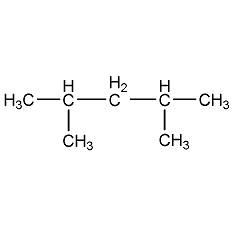
Structural formula
| Business number | 02WB |
|---|---|
| Molecular formula | C7H16 |
| Molecular weight | 100.20 |
| label |
diisopropylmethane, Isopropyl isobutane |
Numbering system
CAS number:108-08-7
MDL number:MFCD00008945
EINECS number:203-548-0
RTECS number:None
BRN number:1696855
PubChem number:24865713
Physical property data
1. Properties: colorless liquid[1]
2. Melting point (℃): -123.4[2]
3. Boiling point (℃): 80.5[3]
4. Relative density (water=1): 0.673[ 4]
5. Relative vapor density (air=1): 3.48[5]
6. Saturated vapor pressure (kPa) :22.7 (37.7℃)[6]
7. Heat of combustion (kJ/mol): -4802.4[7]
8. Critical temperature (℃): 247.1[8]
9. Critical pressure (MPa): 2.78[9]
10. Octanol/water partition coefficient: 3.63[10]
11. Flash point (℃): -12.22[11]
12. Ignition temperature (℃): 335[12]
13. Explosion upper limit (%): 7.0[13]
14. Lower explosion limit (%): 1.0[14]
15. Solubility: insoluble in water, soluble in ethanol, Ether, benzene. [15]
16. Solubility parameter (J·cm-3)0.5:14.358
17. Eccentricity factor: 0.302
18. Critical compression factor: 0.265
19. Critical volume (cm3·mol– 1): 418
20. Critical density (g·cm-3): 0.240
21. van der Waals area (cm 2·mol-1): 1.097×1010
22. van der Waals volume (cm 3·mol-1): 78.470
23. Gas phase standard combustion heat (enthalpy) (kJ·mol-1): -4839.51
24. Gas phase standard claimed heat (enthalpy) (kJ·mol-1): -201.71
25. Gas phase standard entropy (J· mol-1·K-1): 397.02
26. Gas phase standard formation free energy (kJ·mol-1): 3.5
27. Gas phase standard hot melt (J·mol-1·K-1): 170.75
28. Liquid phase standard combustion heat (enthalpy) (kJ·mol-1): -4806.62
29. Liquid phase standard claimed heat (enthalpy) (kJ·mol-1): -234.60
30. Liquid phase standard entropy (J·mol-1·K-1) : 303.17
31. Liquid phase standard free energy of formation (kJ·mol-1): -1.63
32. Liquid phase standard hot melt (J ·mol-1·K-1): 224.22
Toxicological data
1. Acute toxicity No data available
2. Irritation No data available
Ecological data
1. Ecotoxicity No data available
2. Biodegradability No data available
3 .Non-biodegradability No information available
4. Other harmful effects[16] This substance is harmful to the environment and should be treated with special Pay attention to the surfacePollution of water, soil, atmosphere and drinking water.
Molecular structure data
1. Molar refractive index: 34.39
2. Molar volume (cm3/mol): 144.8
3. Isotonic specific volume (90.2K ): 305.4
4. Surface tension (dyne/cm): 19.7
5. Polarizability (10-24cm3): 13.63
Compute chemical data
1. Reference value for hydrophobic parameter calculation (XlogP): 3.4
2. Number of hydrogen bond donors: 0
3. Number of hydrogen bond acceptors: 0
4. Number of rotatable chemical bonds: 2
5. Number of tautomers: none
6. Topological molecule polar surface area 0
7. Number of heavy atoms: 7
8. Surface charge: 0
9. Complexity: 29.3
10. Number of isotope atoms: 0
11. Determine the number of atomic stereocenters: 0
12. Uncertain number of atomic stereocenters: 0
13. Determine the number of chemical bond stereocenters: 0
14. Number of uncertain chemical bond stereocenters: 0
15. Number of covalent bond units: 1
Properties and stability
1. Stability[17] Stability
2. Incompatible substances[18] Strong oxidants, strong acids, strong bases, halogens
3. Polymerization hazards[19] No polymerization
Storage method
Storage Precautions[20] Store in a cool, ventilated warehouse. Keep away from fire and heat sources. The storage temperature should not exceed 37°C. Keep container tightly sealed. They should be stored separately from oxidants, acids, and halogens, and avoid mixed storage. Use explosion-proof lighting and ventilation facilities. It is prohibited to use mechanical equipment and tools that are prone to sparks. The storage area should be equipped with emergency release equipment and suitable containment materials.
Synthesis method
None
Purpose
1. Used in organic synthesis, mainly used to synthesize vinylon, and also used in the adhesive and coating industries. Used in resin fiber synthesis, and also used as an intermediate and adhesive for oil pour-reducing thickeners.
2. Used in organic synthesis. [21]

 微信扫一扫打赏
微信扫一扫打赏

